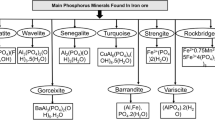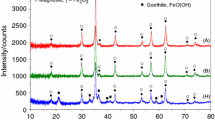Abstract
The preparation of highly dispersed composite iron—copper powders with various concentrations of copper from mixed iron and copper oxalates was studied. The physico-chemical properties of the powders were determined. The powders were corrosion resistant, hydrophilic, practically monodispersed, bacteriocidal and tolerated the sterilization at elevated temperatures. Their magnetic properties could be regulated in the process of forming the initial components. Such powders can be useful in medicine, biology and technology.
Similar content being viewed by others
References
T. M. Shvets, E. P. Zhelibo, Z. M. Mel'nichenko, and V. P. Vasilenko,Physical Chemistry of Highly Dispersed Ferromagnets [in Russian], Nauka, Dumka, Kiev (1985).
T. M. Shvest, N. F. Kushchevskaya, Z. M. Mel'nichenko, and T. S. Maksimenko, “Corrosion resistance of highly dispersed iron,”Poroshk. Metall., Nos. 7–8, 100–104 (1994).
F. Umland, A. Jansen, D. Thierig, and G. Wünsh,Complex Compounds in Analytical Chemistry [Russian Translation], Mir (1975).
V. A. Nazarenko, V. P. Antonovich, and E. M. Nevskaya,Hydrolysis of Metal Ions in Dilute Solutions [in Russian], Atomizdat, Moscow (1979).
I. D. Shigina and S. U. Kreingol'd,Reactions and Very Pure Substances, Vol. 2, Nauka, Moscow (1982), pp. 25–27.
V. V. Stepin and E. V. Silaeva,Analysis of Non-Ferrous Metals and Alloys [in Russian], Metallurgiya, Moscow (1974).
T. A. Potanova,Methods of Analysis of Highly Pure Substances [in Russian], Nauka, Moscow (1965).
Yu. A. Zolotov and N. M. Kuz'min,Concentration of Microelements [in Russian], Khimiya, Moscow (1982).
K. B. Yatsimirskii and V. P. Vasil'ev,Instability Constants of Complex Compounds [in Russian], Izd. Akad. Nauk. SSSR, Moscow (1959).
K. B. Yatsimirskii,Kinetic Methods of Analysis [in Russian], Khimiya, Moscow (1967).
N. M. Dyatlova, V. Ya. Temkina, and I. D. Kolpakova,Complexons [in Russian], Khimiya, Moscow (1970).
V. N. Podchainova and L. N. Simonova,Analytical Chemistry of Elements. Copper [in Russian], Nauka, Moscow (1990).
S. S. Gorelik, L. N. Rastorguyev, and Yu. A. Skakov,X-Ray Diffraction and Electron Diffraction Analysis [in Russian], Metallurgiya, Moscow (1970).
E. M. Burova and N. P. Zhidkov, “Information search system for x-ray diffraction phase analysis,”Kristallografiya,22, No. 6, pp. 1182–1190 (1977).
N. E. Buyanova, G. B. Gupkova, and A. P. Karnaukhov, “Determination of the specific surface are of solid bodies by the method of heat absorption in argon,”Kinet. Katal.,6, 1085–1091 (1965).
V. N. Chechernikov,Magnetic Measurements [in Russian], Izn. Mosk. Univ., Moscow (1963).
Additional information
Institute of Colloid and Water Chemistry, Ukraine National Academy of Sciences, Kiev. Translated from Poroshkovaya Metallurgiya, Nos. 7–8(402), pp. 1–4, July–August, 1998.
Rights and permissions
About this article
Cite this article
Kushchevskaya, N.F. Highly dispersed composite iron—Copper powders obtained from oxalates by a thermochemical method. Powder Metall Met Ceram 37, 343–346 (1998). https://doi.org/10.1007/BF02676012
Received:
Issue Date:
DOI: https://doi.org/10.1007/BF02676012




